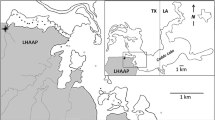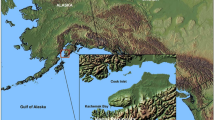Abstract
Baltimore Harbor, a tributary area of the northern Chesapeake Bay, has recelved and is receiving large quantities of chemical pollutants. As part of a cooperative study to explore possible corrective treatment for existing pollution burdens, gross bioassay analyses were performed for sediments from nine representative stations, employing two species of fish, mummichogs (Fundulus heteroclitus) and spot (Leiostomus xanthurus), and one mollusc, the soft-shell clam (Mya arenaria). Acclimated organisms were exposed in static systems to a series of concentrations of suspended sediment from each station, to fuller's earth in suspension, and in control tanks for 48 hours. Parallel analysis of the sediment was performed for the metals, Pb, Cr, Zn, Ca, As, for PCB's and for hexane extracts.
The sediments were all substantially polluted with low correlations among components. Twenty-four hour TLm and 48-hour TLm increased proportionately with sediment concentration but display species specificity. The relationships observed permit use of mummichog data to index gross toxicity of sediments throughout the harbor. Further comparison of mummichog 24-hour TLm value with benthie species diversity determined in a previous study permitted zoning of the entire harbor into highly toxic, moderately toxic, low toxic and slightly toxic zones. Gross toxicity of sediments determined by bioassay can therefore be used as an index of the suitability of the sediments for benthic macroinvertebrate communities.
Similar content being viewed by others
Literature Cited
American Public Health Association. 1971. Standard methods for the examination of water and wastewater. 13th Edition. 874 p.
Bricker, O. P. 1975. Report on the handling and preparation of dredged soil samples prior to analysis for metals and other constituents (Mimeo), 30 p.
Bliss, C. L. 1937. The calculation of the time-mortality curve.Ann. Appl. Biol. 24(4):815–852.
Center for Environmental and Estuarine Studies. 1975. A biological study of Baltimore Harbor. Center for Environmental and Estuarine Studies, University of Maryland, Special Report No. 6, 115 p.
Davis, C. C. 1948. Studies of the effects of industrial pollution in the lower Patapsco River area; 2. The effects of copper as pollution on plankton. Chesapeake Biological Laboratory Publ. No. 72, 12 p.
Finney, D. J. 1971. Probit analysis. Third edition, Cambridge University Press, N. Y., 333 p.
Garland, C. F. 1952. A study of water quality in Baltimore Harbor. Chesapeake Biological Laboratory Publ. No. 96, 132 p.
Gordon, R. B., D. C. Rhoads, and K. K. Turekian. 1972. The environmental consequences of dredge spoil in central Long Island Sound: 1. The New Heaven spoil ground and New Heaven Harbor. Department of Geography, Yale Univ., 39 p.
Isaac, R. C. G. 1965. The contribution of bottom muds to the depletion of oxygen in rivers and suggested standards for suspended solids.In Tarzwell, C. (Ed.), Biological problems in water pollution. U. S. Public Health Service Publ. No. 997-WP-25.
Krizek, R. J., G. M. Karadi, and P. O. Hummel. 1973. Engineering characteristics of polluted dredgings. Northwestern Univ., Evanston, Illinois, Tech. Rept. No. 1, 335 p.
Lee, G. F., and R. H. Plumb. 1974. Literature review on research study for the development of dredged material disposal criteria. Inst. Envir. Stud., Univ. Texas, Dallas. DMRP Rept. D-74-1, 145 p.
Maryland Environmental Service. 1974. Water quality management plan for Patapsco and Back River basins.
McErlean, A. J., and J. A. Mihursky. 1968. Species diversity, species abundance of fish populations: An examination of various methods. 22nd Annual Conf. SE Ass. Game Fish Comm., Baltimore, Maryland, Oct. 21–23, 1968, p. 367–372.
Morton, J. W. 1976. Ecological impacts of dredging and dredge spoil disposal: A literature review. M.S. Thesis, Cornell University, Ithaca, N.Y., 112 p.
Olson, R. A., H. F. Brust, and W. L. Tressler. 1941. Studies of the effects of industrial pollution in the lower Patapsco River area: 1. Curtis Bay region, 1941. Chesapeake Biological Laboratory Publication No. 43, 40 p.
Prater, B. L. 1977. A 96-hour bioassay of Otter Creek, Ohio.J. Wat. Pollut. Contr. Fed. 49:2099–2106.
Reynolds, T. D., R. W. Hann, Jr., and W. P. Priebe. 1973. Benthic oxygen demands of Houston Ship Channel sediments. Texas A & M Univ., TAMU-SG-73-204, 58 p.
Saila, S. B., S. D. Pratt, and T. T. Polger. 1972. Dredge spoil disposal in Rhode Island Sound. University of Rhode Island, Marine Tech. Rept. No. 2, 48 p.
Skelly, M. J. 1973. Water quality of Baltimore Harbor. Quick, Lawler and Matusky Engineers, N.Y.
Slotta, L. S. 1974. Dredging problems and complications.In Coastal zone management problems. Oregon St. Univ., Water Resources Institute, SEMNWR 018-74, 90 p.
Thomson, J., K. K. Turekian, and R. J. McCaffrey. 1973. The accumulation of metals in and release from sediments of Long Island Sound. Dept. Geol. Geophys., Yale Univ., 11 p.
Villa, O., Jr., and P. G. Johnson. 1974. Distribution of metals in Baltimore Harbor sediments. Envir. Prot. Eg., Annapolis Field Lab., Reg. 111, EPA-903/9-74-012.
Author information
Authors and Affiliations
Additional information
Contribution No. 872, Center for Environmental and Estuarine Studies. University of Maryland.
Rights and permissions
About this article
Cite this article
Tsai, CF., Welch, J., Chang, KY. et al. Bioassay of baltimore harbor sediments. Estuaries 2, 141–153 (1979). https://doi.org/10.2307/1351728
Issue Date:
DOI: https://doi.org/10.2307/1351728




